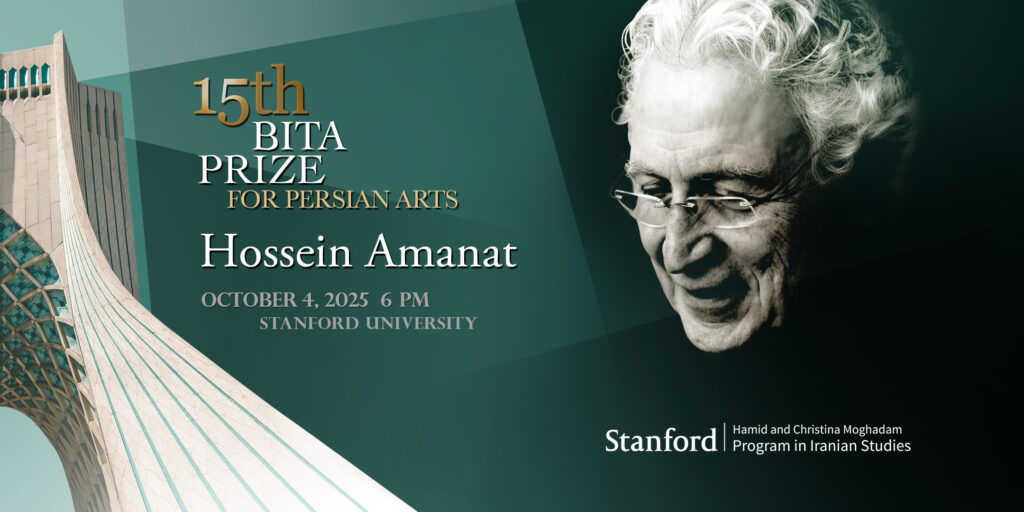
Azadi Homestay sits just 20 minutes away from the iconic Azadi Tower by car, a landmark so intimately tied to Tehran’s skyline that it has become a symbol of modern Iran. Yet few pause to reflect on the architect behind that emblematic monument: Hossein Amanat. In light of his recent recognition by Stanford University with the 15th Bita Prize for Persian Arts, it’s timely to revisit Amanat’s life, philosophy, and legacy, and to connect them to what Azadi Homestay offers visitors today. (sgs.stanford.edu)
A Monumental Beginning
- Amanat’s acclaim began when, as a newly graduated architect in 1966, he won the national competition to design the Shahyad Monument, later renamed Azadi Tower. (sgs.stanford.edu)
- The design was bold and ambitious: rather than adopting a purely international style, Amanat sought a fusion — one that hybridized modern structural techniques with echoes of traditional Persian and Islamic forms (arches, vaults, ornamental geometry). (sgs.stanford.edu)
- The tower’s form — elegant curves, soaring presence, and sculptural lightness — made it an architectural icon. Over time, it transcended its physical function to become a national symbol of identity, aspiration, and memory.
A Life of Synthesis, Disruption, and Renewal
- Hossein Amanat was born in 1942 in Iran. Even at such a young age, he was entrusted with designs of national significance — a rare opportunity that reflects both his talent and the modernizing ambitions of Iran in the 1960s. (sgs.stanford.edu)
- His work includes not just Azadi Tower but major commissions such as:
• The Persian Heritage Centre
• The School of Management at the University of Tehran
• Design work for Aryamehr (now Sharif) University of Technology
• The Iranian Embassy in Beijing, considered one of the architectural highlights in that diplomatic district
• Urban planning efforts, e.g. Darya Kenar, a new town on the Caspian Sea (sgs.stanford.edu) - Crucially, Hossein Amanat adopted what was then a pioneering approach: at a time when many architects in Iran followed the International Style (glass boxes, steel frames, global minimalism), Amanat strove to integrate the legacy of Persian architecture — the ornamental, the symbolic, the spatial — with the formal and technological possibilities of the present. (sgs.stanford.edu)
However, his professional life in Iran was dramatically interrupted by political events:
- After the 1979 Islamic Revolution, as someone of the Baha’i faith, Amanat and his family were persecuted. He was forced into exile. (sgs.stanford.edu)
- After a sojourn in Europe, his family emigrated to Canada in 1980. There, Amanat rebuilt a meaningful and diverse architectural practice. (sgs.stanford.edu)
- He also engaged in academic and cultural efforts:
• He became part of the founding faculty of the Baha’i Institute for Higher Education (BIHE), a grassroots institution formed in response to restrictions on Baha’i access to formal education in Iran. (sgs.stanford.edu)
• He contributed as a visiting critic at the University of British Columbia’s School of Architecture and Landscape Architecture. (sgs.stanford.edu)
• In 2024, he was awarded an honorary Doctor of Letters by UBC, commemorating his lifetime achievements and continued influence. (sgs.stanford.edu)
Recognition: The Bita Prize and Its Significance
Stanford University’s Center for Global Studies awarded Hossein Amanat the 15th Bita Prize for Persian Arts in October 2025. The Bita Prize honors an Iranian creator whose lifetime work exhibits both aesthetic distinction and a commitment to artistic freedom. (sgs.stanford.edu)
In naming Amanat, the prize committee acknowledged:
- His groundbreaking early work designing the Azadi Monument, a singular achievement for a young architect. (sgs.stanford.edu)
- His broader portfolio of buildings and cultural projects that, over time, lent shape to modern Iran’s architectural identity. (sgs.stanford.edu)
- His efforts in exile on behalf of education, culture, and architectural discourse — asserting that architecture is not just form but part of a larger intellectual and civic life. (sgs.stanford.edu)
Why Amanat Matters to Azadi Homestay
At Azadi Homestay, we don’t merely offer lodging near the tower — we offer a window into the narrative that the tower itself embodies. Here’s how Amanat’s legacy resonates with our mission:
- Cultural Continuity
Amanat’s work reminds us that modern buildings can deeply engage with the past. Staying near Azadi Tower invites guests to see not only the physical structure but also its symbolic layering — how old and new, aspiration and tradition, converge in urban space. - Architectural Inspiration
We can curate experiences (guided walks, interpretive placards, design-focused tours) that help visitors appreciate not just the monument’s scale but its structural logic, materials, geometry, orientation, and interplay of solids and voids. Through such programming, guests might see the tower not just as a photo backdrop but as a living text. - A Narrative of Resilience
Amanat’s life — disrupted by exile and transformed in diaspora — speaks to perseverance, reinvention, and the continuity of creativity beyond borders. This is a narrative we can share with our guests: that architecture is not static, but part of a human journey. - A Living Dialogue
Because Amanat’s architecture invites questions (Why these forms? How do they relate to Persian art? How do they function in a modern city?), Azadi Homestay can serve as a small cultural hub — prompts, exhibitions, and readings about Amanat’s influence might enrich a guest’s stay. In this way, the homestay is not just lodging but a place of reflection.